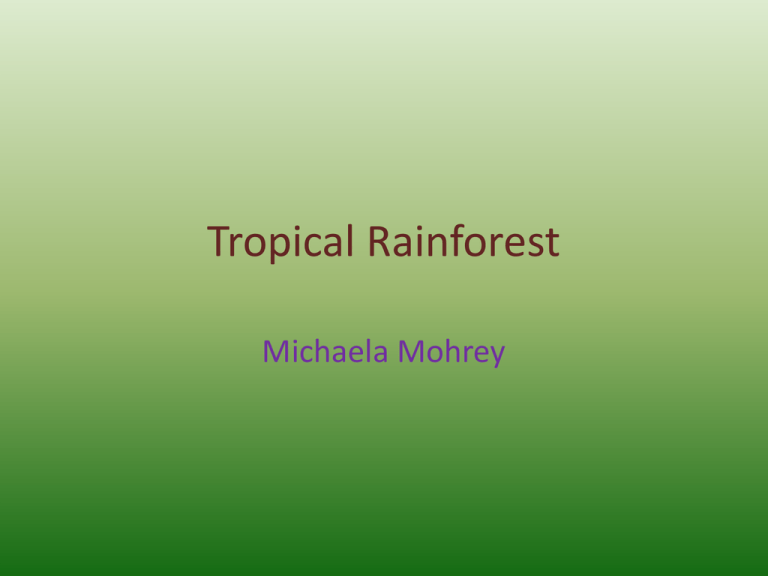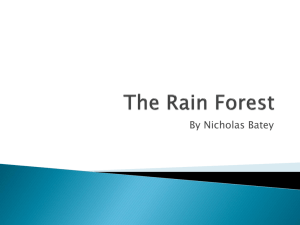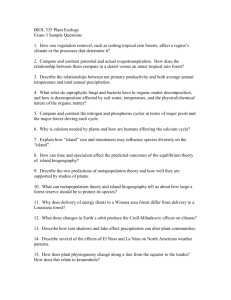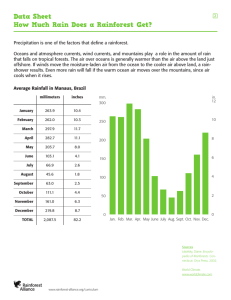Tropical Rainforest - tccsmrirons
advertisement

Tropical Rainforest Michaela Mohrey Location • North central America, South America, Africa, Asia, Australasia Abiotic factors • A forest of tall trees. • A region of year round warmth. • Temperatures rarely gets higher then 93. degrees or drops lower then 68 degrees. • Humidity is between 77 and 88%. • More then 100 in. of rainfall each year. • Almost all rain forests are near the equator. • Rainforests cover less then 6% of the earths land. • Tropical rain forests produce 40% of the earths oxygen. Animals of the rain forest • Toco Toucan- largest of the toucans. • Colored bright orange and black. • Likes to live in open areas, lowland rain forest and palm groves of south America. • Live in flocks, in holes in trees • They eat lizards, snakes, and steal eggs from smaller birds. Continued.. • Sumatran Rhinoceros- lives in the Pockets of Indonesian and Malaysian rain forests. • Smallest living rhinoceros. • Their body length is from 8 to 8.5 feet and stands 4.5 feet from their shoulders. • They prefer higher elevations, are found near water and mud wallows. • They eat wild mangoes, figs, fish, a variety of plants, bamboo. Continued… • Slender Loris- are only found in • the rain forests of India and Sri Lanka. • Can live in dry and wet forests but they prefer thick thorny vegetation where they can escape predators and are easily able to find food. • Main diet are insects, but will eat flowers, leaves, shoots, and sometimes eggs and nestlings. • They eat a lot of bad smelling insects, they will wipe urine over feet, face, and hands to avoid the sting of toxic insects. • Only the size of a chipmunk. • They live in trees and spend most of their time in them. Plants of the rain forest • Bengal Bamboo- can be found in the Southeast Asian rainforest. • It does very well in moist areas with a lot of rain. • It likes temperatures between 40 degrees Fahrenheit, and 100 degrees Fahrenheit. • Can grow from anywhere to 40 to 80 feet in height. • Very important to the environment they can reduce soil erosion, sucks up water from heavy rains that may cause flooding. • They only flower once in their life time then die after they bloom. Continued.. • Jambu- grows naturally in southern India to eastern Malaya. • Jambu is a small tree or large shrub which grows 10 to 20 feet in height. • They are pink when young and become light-green above and yellowish-green beneath when mature. • Jambu fruit can be white to a pinkish color, they are very sweet and juicy. • Considered poisonous. Continued… • Strangler figs- Most important plant of the rain forest ecosystem. • Numerous animal species feed on the fruit of the fig tree. • In some forests up to 70% of its animals depend on figs for their diet. • They are tall canopy trees which can grow to 148 feet in height. • Kill the host tree that they are attached to. Animal Adaptations • Because there are so many animals in the rain forest many have adapted to eating foods that no other animal eat. • Certain animals develop special features to help them adapt to the environment for example the toucan developed long, thick beaks to they can reach fruit on trees, also to cut the fruit. • Some animals use behavioral adaptions like the sloth, they move very slow and hang upside down on trees, also they grow green algae on their fur to make it more difficult for predators to see them. Plant adaptations • Plants need to be able to adapt strategies to find sunlight. • Some plants attach themselves to other plants so they can grow higher up and reach the canopy, killing the host plant. Human interactions • Humans are logging a lot of the trees in the rain forests for our needs like paper, and furniture. • The rain forest is effected by water and air pollution because of industrial operations and activities. • Poaching has made animal populations decrease. • Products that are sold in America a lot of them are made out of plants or trees in the rain forest, making homes for animals, birds, and insects disappear. Interactions in the Rainforest • Ants interact a lot with the plants in the rain forest, the ants that live in the Macaranga tree protect the tree from other plants growing on it. Bibliography • http://www.blueplanetbiomes.org/rnfrst_clim ate_page.htm • www.cotf.edu • http://grmsbiomes.pbworks.com





